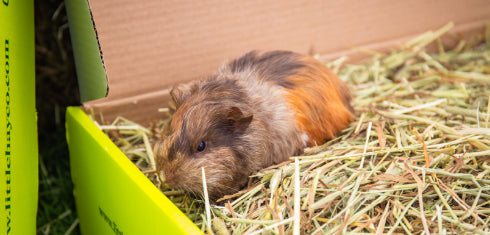ALL ABOUT THE EARS 

Whether your rabbit is lop-eared or uppity-eared you can tell if your rabbit is confident, relaxed, curious or scared. Even lop rabbits, who have much less control over their ears are able to tell us a lot about their emotions. For many breeds of rabbits, the ears will naturally be close together and touching when they are relaxed.
The default rabbit ear position is upright and relaxed. The ears will usually be wide apart and not touching or close together but that can depend on the breed of rabbit. Some breeds naturally have close-set and when rabbits get scared, they will hold their ears upright and keep them in that position. The opening of the ear will often face directly forward, but the ears can also face towards a different direction where the sound is heard.
When a lop-eared rabbit rigidly swings their ears up and back this is similar to the aggressive or defensive ear signals that uppity-eared rabbits show. Not all lop-eared rabbits have enough control of their ears to push them in this position.
When rabbits lay their ears down along their back they are relaxing. Typically you will notice this when your rabbit is loafing or relaxed. They feel safe and content in their surroundings.
Sometimes rabbits don’t feel threatened at all but they still want to pay attention. If your rabbit is relaxed or in a loaf position, they may have one ear up to let you know they are lazily aware. They will keep one ear up to maintain a basic level of awareness.
Rabbits will swivel their ears in any direction to listen to sounds around them. Most of the time this is just a cursory level of alertness for rabbits and will instinctively move their ears to catch any noise.
Sometimes you will also notice your rabbit shaking their ears. This is a behavior that actually has a few different meanings depending on the context.
Lop rabbit ears are more challenging to understand than uppity-eared rabbits. Lops have far less control over their ears and cannot always put their ears in the same position as other rabbits. Most lop rabbits can still rotate their ears but with limited ear mobility. Some lop rabbits have more control over their ears than others. They might even be able to move their ears into a fully upright position. However, most lops will not be able to raise their ears very far or not able to lift their ears at all.
By default, lop rabbit ears will rest gently on their sides. They will just be pointed in towards your rabbits body. When your rabbit moves or hops around you see the movement in their ears since they are not being held in any particular position.
These relaxed ears imply that your rabbit is generally happy and comfortable. They don’t feel like there is an imminent threat that they need to be aware of so they let their ears hang in a natural position.
While lop-eared rabbits have limited mobility in their ears, they can still rotate them a little. They can swivel one of both ears in the direction of nearby sounds when they are curious or trying to pay attention. Sometimes when a lop-eared rabbit tries to rotate one ear, they will also turn their head a little to more easily to hear the sound.
Another common position you will see in lop-eared rabbits who have greater mobility is known as airplane ears. Not all rabbits are capable of this but those with the strength will lift their ears to a horizontal position, looking like an airplane.
Most commonly you will see this behavior when your rabbit is very excited. You may also see it when your rabbit is on the alert. Holding their ears like this makes it easier to hear sounds around them, so they may be trying to identify the direction of a threatening noise. Not all lop-eared rabbits have enough control of their ears to push them in this position.











